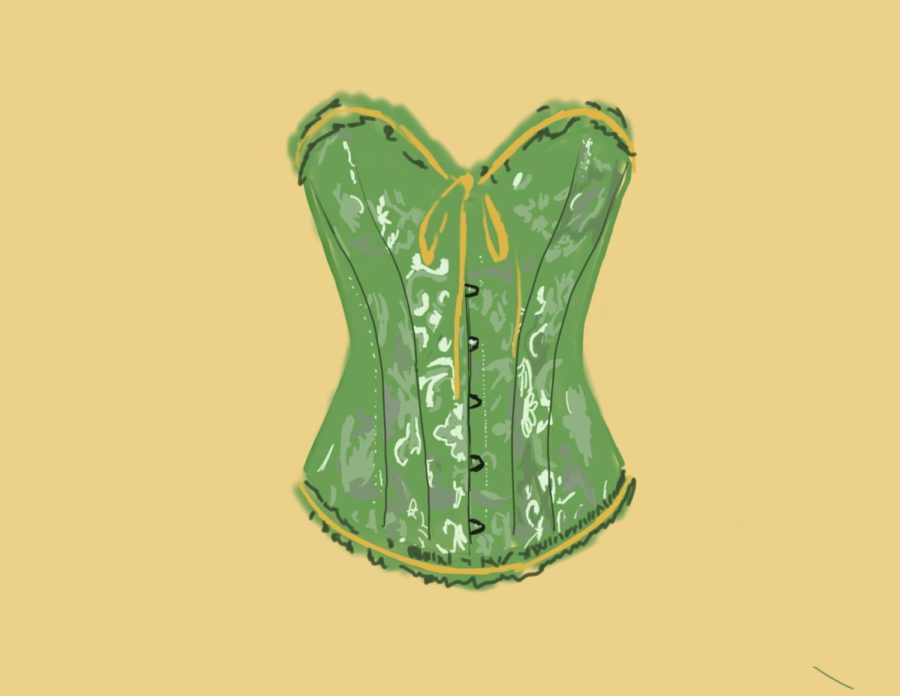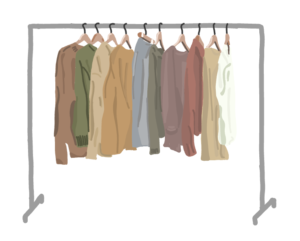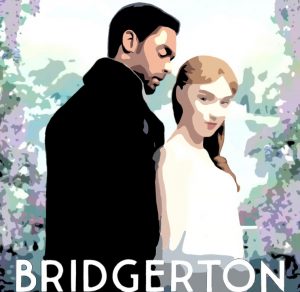The history behind corsets: how a piece of clothing sparked controversy, criticism and empowerment
The corset has symbolized both the oppression and empowerment of women throughout history.
February 1, 2022
Introduction
The word “corset” can conjure countless images in one’s mind. Some may think of a tightly laced, organ-squishing garment worn by women in the 18th and 19th centuries to achieve an hourglass figure–the type that is referenced in historical television dramas and movies such as Bridgerton and Enola Holmes. Others may be reminded of the latest trend of modern, fashionable corsets, popularized by celebrities such as Billie Eilish, Bella Hadid and others, and may even have one in their closet.
Yet, the reasons why these differing opinions and stereotypes exist are often ignored and not understood. Throughout history, corsets have been one of the most controversial and significant pieces of clothing, representing a chasm between patriarchy and feminism. A deeper exploration of this history reveals how views on the corset often reflect changes in a woman’s role in society and how they both benefited women and held them back.
The origin of corsets
While corsets may have dated way back from the Bronze Age Minoan civilization in 1600 BCE, the garment didn’t gain more prominence until the Middle Ages and Renaissance era, as they started to become commonly worn by European royalty.
According to Britannica, corsets were originally associated with the wealthy elite, yet were adopted by the bourgeoisie, or middle class, by the 17th century. These stiffening undergarments that pushed the breasts up came in many different materials and designs, such as iron corsets that were used for orthopedic purposes (not for torturing people). The popularity of corsets is reflected by paintings of royalty wearing the garment, such as Elizabeth I and Catherine de Medici (who was also widely claimed to have introduced iron corsets).
By the Regency era from 1795 to 1837, corsets were fully integrated into British society. The Netflix Regency period drama “Bridgerton” features an opening scene in which Prudence Featherington (Bessie Carter), one of the eligible daughters of a noblewoman, squeezes into a tightly-laced corset. The noblewomen presses the maid fitting the garment to pull tighter, as a concerned sibling says, “Is she to breathe, Mama?”
This scene is visibly intended to symbolize the lack of control that women had over their lives in the time period, yet in reality, further promotes misconceptions about corsets.
Ironically, the Regency era ushered experiments and variety in how a woman could wear a corset, leading to a plethora of different designs. Apart from the materials of the corset, the other contributor to its “body damaging” reputation was tight-lacing. As corset designs and styles were constantly changing, it wasn’t until the implementation of the “metal eyelet” in the early 19th century﹘the holes through which the laces crossover through﹘that tight-lacing became recognized.
But, tight-lacing was not synonymous with corsets of the Regency period, which “were made of soft cotton with stiffer cotton cording for support, and a slot in the front for a metal or wooden support called a busk,” according to Smithsonian magazine. Corsets were much more similar to modern bras with a variety of designs, as women could wear more comfortable corsets at home while wearing tighter corsets at a ball. This plays a striking contrast to a suffocating torture machine one may imagine after watching shows like Bridgerton.
Two sides of criticism: women’s rights activists and male physicians
The common corset that one often imagines is known as the Victorian corset, created by a man named Joseph Cooper in 1848. Its design came to be pivotal in the sense of comfort women supposedly received in comparison to previous designs, such as the iron corset. His design included “a front fastening busk, allowing the corset to be taken on and off without being unlaced at the back,” according to ExploreTheArchive.com. Not that it made much of a difference because corsets were expected to be worn at almost all times, but now it even allowed women to participate in certain sports with better ease of movement.
This was a colossal improvement given the time period and setting. Even though most of continental Europe had just experienced the Age of Enlightenment, it didn’t benefit women in terms of their role in daily life as much as it did men. To fit in with societal norms, women were expected to continue their usual household chores and take care of the children, while also being expected to wear the corset at all times. It began to enrage women as it became a part of the many things that severely restricted women’s rights during the 1800’s, by limiting the breathing space for a women’s waist and emphasizing and elevating the upper body to the man’s liking.
It was around this time that corsets began to receive more criticism from two contrasting groups: women’s rights activists, who advocated for dress reforms and practical clothing options, and male physicians, who supposedly exaggerated skeletal and organ deformities caused by the garment.
Although one could argue that some women felt as though the traditional corset was a distinguished symbol of a woman’s femininity, most of them felt as though they were being coerced by societal norms to wear such an uncomfortable piece of clothing while holding the role of housewife.
The Netflix period film which is set in 1884, “Enola Holmes” features a young teenage girl who openly disagrees with what’s expected of a woman, and as a result she acts and dresses the opposite. In an attempt to hide from someone she decides she must become something unexpected. Enola puts on a Victorian corset and explains, “ The corset: A symbol of repression for those who are forced to wear it. But for me who chooses to wear it, the bust enhancer and the hip regulators. And as they do so, they will make me look like that truly unlikely thing: A lady!”
Yet, it is incorrect to assume that all women’s rights activists completely opposed corsets. Lydia Becker, the author of the “Women’s Suffrage Journal” wrote, “stick to your stays.” According to Heather Munro Prescott, corsets provided women with a socially-acceptable form of self-expression, despite also reinforcing “traditional notions of femininity by focusing attention on women’s physical appearance rather than their accomplishments.” This further displays the nuanced history of corsets, and why they weren’t necessarily the most accurate symbols of oppression.
Corsets also were subject to medical criticism, some of which were accurate but others exaggerated. Tight-lacing did cause expansion of the lungs while taking a breath and caused atrophy of the back and pectoral muscles. However, some studies say tight-lacing was actually uncommon, and most Victorian corsets weren’t nearly that uncomfortable.
The medical criticism from male physicians in the Victorian era on corsets had little scientific backing. While corsets did cause organs to shift and affected digestion, they weren’t life-threatening. Surprisingly, according to a study conducted by American University master’s student Rebecca Gibson, corsets did not negatively impact a woman’s quality of life, and corseted women actually lived longer on average than women who did not wear corsets. Yet, the medical critiques of the Victorian era often supported the claims of women suffragists.
The downfall and resurgence of corsets
In the 1900s, corsets gradually grew out of fashion as women became more involved in sports and exercise. While the bicycle craze did lead to the creation of the sports corset that held the breasts in place while allowing for unrestricted movement, women oriented themselves towards more free-flowing outfits. To obtain the thin waist, hourglass shape, women began dieting and exercising more, rather than relying on tight clothing to form their ideal body.
Some fashion designers of the 1910s and 1920s stopped incorporating the corset altogether in their dresses and outfits. Paul Poiret (1879-1944) claimed that he was one of the first to reject the corset with his loose silhouettes formed with draped fabric. World War I also led to more women wearing uniforms and simple cotton designs, rather than rigid designs. Overall, corsets were no longer commonly worn due to a switch to more practical types of clothing.
Later on, during the post-World War II era, corsets even became a symbol of male oppression among feminists. In a protest in a Miss America beauty pageant, protestors symbolically threw traditionally feminine items into a “Freedom Trash Can,” which included corsets among other items such as diapers and stiletto heels.The corset was seen as a piece of clothing that sexualized women and limited women to a reductive form of femininity.
Even though society began to reject the idea of normalized corsets, that didn’t stop actresses from wearing them. Corsets were not unusual to see on the silver screen, on treasured celebrities such as Marilyn Monroe or Audrey Hepburn. Despite this though, corsets never sustained popularity in the 1960s.
The corset experienced a resurgence in the 1970s and 1980s, as fashion designers such as Vivienne Westwood and Jean-Paul Gaultier reestablished corsets as a symbol of female empowerment. Gaultier’s most popular design was iconically worn by Madonna during her Blonde Ambition tour. This signaled a shift for corsets to be worn as outerwear, rather than underwear, which continued well into the 21th century (the type of corsets that you may bump into on your Tik Tok feed).
Corsets in the present-day
As women’s fashion continually changes everyday, present-day women and even men have begun to incorporate corsets in their wardrobe. As seen in social media and televised events, celebrities and influencers have been wearing the very corset that women in the 19th century were fighting hard to get away from. But the corset design has changed drastically, from being worn as a restricting undergarment to becoming outerwear and often worn to replicate “retro” fashion.
The surge of celebrities wearing corsets may be in style for them, but that didn’t necessarily cause the current popularity of corsets. As many celebrities wore them to award shows and the Met Gala, which is notorious for its large spectrum of anomalous outfits, it wasn’t considered clothing one would wear normally. For the public, corsets became somewhat associated with these outlandish celebrity outfits
TikTok on the other hand has been a key player in the resurgence of corsets. TikTok is a place of a variety of widespread trends, including the corset trend. In the song “Hans of Holbein” by the musical SIX, a small part of the lyrics, “you bring the corset, I’ll bring the cinchers, no one wants a waist over nine inches” has seemingly gone viral with users purchasing a corset, putting it on and tightening the laces while singing the lyrics for a visible dramatic change in their waist size.
Almost immediately, the light green Victorian era looking corset that became the face of the trend became sold out on Amazon, as other TikTok users purchased it to recreate the trend. By the summer of 2021, corsets were almost everywhere to the point it wasn’t even noticeably different or odd. It could be seen on Tiktok, Instagram, Pinterest and other social media platforms, and became even more popular by the sudden amount of celebrities wearing it to events and nights out.
Unfortunately, as much as it does emphasize the curves of the human body, it can be quite damaging as well. Corsets may not be fit correctly or may require tight-lacing, which makes them detrimental to the muscles and organs of the human body. One might argue that the corset is simply a more fashionable waist trainer, but something that causes such quick visible results cannot be good for anyone.
Explore The Archive points out that corsets “can be impeding garments if they’re not made to fit the body properly, and if the body isn’t given time to adjust to them.” Most modern corsets are mass-manufactured and have a more restricting design, often making them painful and uncomfortable.
Bernadette Banner, known for her YouTube channel that explores historical attire, compared a modern, steampunk fashion corset with her Victorian corsets in a video. After trying on the modern corset, she explains how the steel bones on the corset dig into her actual bones, causing hip pain after only five minutes of wearing the garment.
This is also one of the major reasons why present-day actresses describe devitalizing side effects to corsets when required to wear them for historical TV shows and movies. Lily James mentioned that while filming “Cinderella,” she was on a liquid diet due to the tight-fitting corset and dress she wore, and Cara Delevingne said that she lost her voice. Due to tight movie schedules, corsets often don’t fit properly, leading to pain and even structural deformities.
The image of corsets has evolved from a staple in everyday women’s attire to a symbol of oppression. Yet, one thing has always stayed constant: contrasting perspectives. We (the authors) struggled with finding sources to draw from, not only because this history dates back so long, but also because some viewpoints blatantly contradict each other. One news article would mention how corsets have a detrimental effect on the human body, and another article would disprove this evidence entirely, citing a new study that showed that corsets had virtually no impact on the health of women in the 18th and 19th centuries. How could research still produce such varying results on one piece of garment?
What we didn’t understand at the time was the intricate complexities of this history. Corsets may remind some people of the lack of freedom that women had in the 1700s-1800s, how women lacked a voice in society and were treated as an object for their looks. Others may find it empowering to publicly wear a corset and look good in it. Nevertheless, both of these perspectives are completely valid, and one could share both of these viewpoints too. One would have had to exist in Europe in the 1800’s to understand the constricting perspective women had.
Undoubtedly, the corset revolves around freedom: freedom of self-expression in fashion and beyond, but holds an equally deep history of generations of the common patriarchal society.






